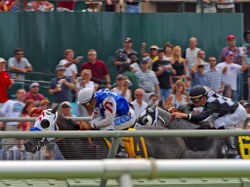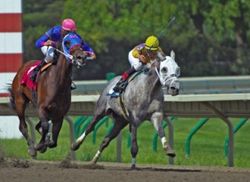 A horse race at Del Mar.
A horse race at Del Mar.
Horse racing is an equestrian sport which has been practiced over the centuries; the chariot races of Roman times are an early example, as is the contest of the steeds of the god Odin and the giant Hrungnir in Norse mythology. It is often inextricably associated with gambling.
Contents |
Forms of horse racing
One of the principal forms of horse racing, which is popular in many parts of the world, is thoroughbred racing. Harness racing is also popular in the eastern United States and more popular than thoroughbred racing in the United Kingdom and Canada. Quarter horse and Arabian racing are also popular in the western United States.
The breeding, training and racing of horses in many countries is now a significant economic activity as, to a greater extent, is the gambling industry which is largely supported by it. Exceptional horses can win millions of dollars and make millions more by providing stud services, such as horse breeding.
Horse racing in North America
 Monmouth Racetrack in New Jersey in May 2005.
Monmouth Racetrack in New Jersey in May 2005.
The style of racing, the distances and the type of events varies very much by the country in which the race is occurring, and many countries offer different types of horse races.
In the United States, races can occur on flat surfaces of either dirt or grass, generally thoroughbred racing; other tracks offer quarter horse racing and harness racing, or combinations of these three types of racing. Racing with other breeds, such as Arabian horse racing, is found on a limited basis. American thoroughbred races are run at a wide variety of distances, most commonly from 4.5 furlongs (905 m) to 1½ miles (2414 m); with this in mind, breeders of thoroughbred race horses are able to breed horses to excel at a particular distance.
The high point of US horse racing has traditionally been the Kentucky Derby which, together with the Preakness Stakes and the Belmont Stakes, form the Triple Crown for three-year-olds. However, in recent years the Breeders' Cup races, held at the end of the year, have been challenging the Triple Crown events, held early in the year, as determiners of the three-year-old champion. They also have an important effect on the selection of other annual champions. The corresponding standard-bred event is the Breeders' Crown. There are also a Triple Crown of Harness Racing for Pacers and a Triple Crown of Harness Racing for Trotters.
American betting on horse racing is sanctioned and regulated by state governments, almost always through legalized parimutuel gambling. Thoroughbred horse racing in the United States has its own Hall of Fame for horses, jockeys, and trainers.
The most famous horses from Canada are Northern Dancer, who after winning the Kentucky Derby and Preakness went on to become the most successful Thoroughbred sire ever, and his son Nijinsky II. In Canada, however, harness racing is more popular than Thoroughbred racing. Woodbine Racetrack in Toronto, home of the Queen's Plate, Canada's premier thoroughbred stakes race, and the North America Cup, Canada's premier standard-bred stakes race, is the only race track in North America which stages Thoroughbred and Standard-bred (harness) meetings on the same day. The North America Cup has the largest purse of any Canadian horse race.
Horse racing in Australia
Racing in Australasia has enjoyed great success with races such as the world famous Melbourne Cup, the so-called race that stops a nation, which has recently attracted many international entries. In Australia, the most famous horse was Phar Lap, who raced from 1928-1932 (though originally bred in New Zealand). In 2003-2005 Makybe Diva became the first and only horse to ever win the Melbourne Cup three times. In harness racing, Paleface Adios became a household name during the 1970s, while Cardigan Bay, a pacing horse from New Zealand, enjoyed great success at the highest levels of American harness racing in the 1960s.
Horse racing in Europe
In the United Kingdom, there are races which involve obstacles (either hurdles or fences) called National Hunt racing and those which are unobstructed races over a given distance (flat racing). The UK has provided many of the sport's greatest ever jockeys, most notably Gordon Richards. See also United Kingdom horse-racing.
In Ireland, noted for its racing history, the Derby-winning thoroughbred Shergar was kidnapped on February 8, 1983. He has never been found. The multiple Gold Cup winner Best Mate also hails from Ireland, while the great Red Rum was bred there, before moving across the Irish Sea to be trained.
Pedigree
While the attention of horse racing fans and the media is focused almost exclusively on the horse's performance on the racetrack, or for male horses possibly its success as a sire, little publicity is given to brood mares. Such is the case of La Troienne, one of the most important mares of the 20th century to whom many of the greatest thoroughbred champions, and dams of champions, can be traced.
Betting
- For more details on this topic, see Gambling.




 216.73.216.81
216.73.216.81 User Stats:
User Stats:
 Today: 0
Today: 0 Yesterday: 0
Yesterday: 0 This Month: 0
This Month: 0 This Year: 0
This Year: 0 Total Users: 117
Total Users: 117 New Members:
New Members:
 216.73.xxx.xx
216.73.xxx.xx
 Server Time:
Server Time: